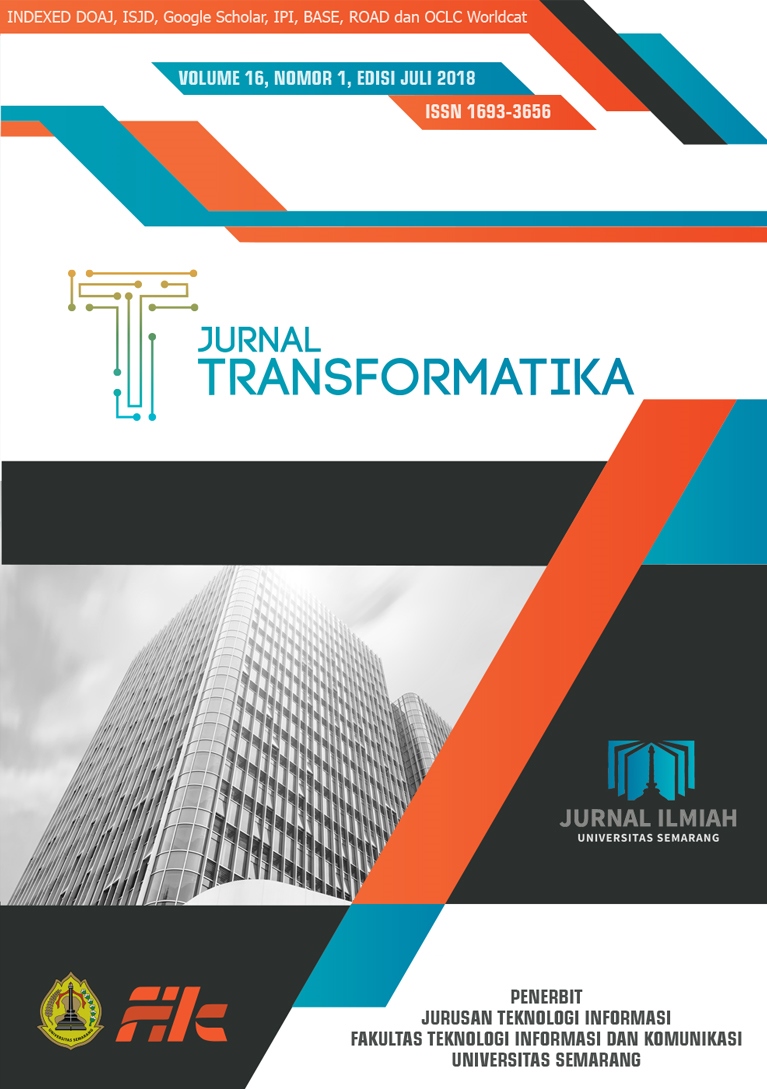Pattern Recognition of Human Face With Photos Using KNN Algorithm
DOI:
https://doi.org/10.26623/transformatika.v19i1.3581Abstract
A Facial photos in today's era are widely used as a media for identity recognition, but not many computer applications provide identity recognition of face photos that contain the names of the photo owners, to make an a prototype the sistems use a KNN algorithm, this algorithm work is by classifying the closest object and grouping it on predetermined objects. In this paper, the object is a face photo where the KNN algorithm will be used to classify the facial patterns contained in the photo. The stages in pattern recognition, starting from preprocessing, feature extraction and then classification. In addition to using the KNN algorithm for data classification, photo of faces will be detected and stored the T-Zone area and frontal face. In this paper 11 images used for data testing and the accuracy will be calculated using a recognition algorithm. The results of this paper are a facial recognition program using python that can display faces with a validity level of 82%.
References
B. Warna, K. Dengan, and M. Template, Penentuan Wilayah Wajah Manusia Pada Citra Berwarna Berdasarkan Warna Kulit Dengan Metode Template Matching, Maj. Ilm. Teknol. Elektro, vol. 5, no. 2, pp. 1 8, 2012, doi: 10.24843/10.24843/MITE.
M. A. Rahman, I. S. Wasista, M. Kom, and L. Belakang, Sistem Pengenalan Wajah Menggunakan Webcam Untuk Absensi Dengan Metode Template Matching, Elektronika, pp. 1 6, 2015.
C. V. Angkoso, J. T. Informatika, F. Teknik, U. Trunojoyo, E. Fitur, and A. Tekstur, Pengenalan Jender Berbasis Tekstur Pada Citra Wajah Foto Digital, Konf. Nas. Inovasi dalam Desain dan Teknol., pp. 119 125, 2011.
I. Santoso, Y. Christyono, and M. Indriani, Kinerja Pengenalan Citra Tekstur Menggunakan Analisis Tekstur Metode Run Length, Semin. Nas. Apl. Teknol. Inf., vol. 2007, no. Snati, pp. 19 25, 2007.
E. Budianita, J. Jasril, and L. Handayani, Implementasi Pengolahan Citra dan Klasifikasi K-Nearest Neighbour Untuk Membangun Aplikasi Pembeda Daging Sapi dan Babi Berbasis Web, J. Sains dan Teknol. Ind., vol. 12, no. Vol 12, No 2 (2015): Juni 2015, pp. 242 247, 2015, [Online]. Available: http://ejournal.uin-suska.ac.id/index.php/sitekin/article/view/1005.
M. A. Naufal, Implementasi Metode Klasifikasi K-Nearest Neighbor (K-NN) untuk Pengenalan Pola Batik Motif Lampung, J. Chem. Inf. Model., vol. 53, no. 9, pp. 1689 1699, 2017, [Online]. Available: http://digilib.unila.ac.id/28648/3/SKRIPSI TANPA BAB PEMBAHASAN.pdf.
F. Liantoni, Klasifikasi Daun Dengan Perbaikan Fitur Citra Menggunakan Metode K-Nearest Neighbor, J. Ultim., vol. 7, no. 2, pp. 98 104, 2016, doi: 10.31937/ti.v7i2.356.
A. Budi, S. Suma inna, and H. Maulana, Pengenalan Citra Wajah Sebagai Identifier Menggunakan Metode Principal Component Analysis (PCA), J. Tek. Inform., vol. 9, no. 2, pp. 166 175, 2018, doi: 10.15408/jti.v9i2.5608.
D. Sutaji and R. Dijaya, Classification of Milk Fish Quality using Fuzzy K-Nearest Neighbor Method Based on Form Descriptor and Co-Occurrence Matrix, J. Phys. Conf. Ser., vol. 1179, no. 1, 2019, doi: 10.1088/1742-6596/1179/1/012021.
Johan Wahyudi and Ihdahubbi Maulida, Pengenalan Pola Citra Kain Tradisional Menggunakan Glcm Dan Knn, J. Teknol. Inf. Univ. Lambung Mangkurat, vol. 4, no. 2, pp. 43 48, 2019, doi: 10.20527/jtiulm.v4i2.37.
R. Armandhani, R. C. Wihandika, and M. A. Rahman, Klasifikasi Gender berbasis Wajah menggunakan Metode Local Binary Pattern dan Random KNN, J. Pengemb. Teknol. Inf. dan Ilmu Komput., vol. 3, no. 8, pp. 7575 7582, 2019.
Downloads
Additional Files
Published
Issue
Section
License
Authors who publish with this journal agree to the following terms:
- Authors retain copyright and grant the journal right of first publication with the work simultaneously licensed under a Creative Commons Attribution License that allows others to share the work with an acknowledgement of the work's authorship and initial publication in this journal.
- Authors are able to enter into separate, additional contractual arrangements for the non-exclusive distribution of the journal's published version of the work (e.g., post it to an institutional repository or publish it in a book), with an acknowledgement of its initial publication in this journal.
- Authors are permitted and encouraged to post their work online (e.g., in institutional repositories or on their website) prior to and during the submission process, as it can lead to productive exchanges, as well as earlier and greater citation of published work.

Transformatika is licensed under a Creative Commons Attribution 4.0 International License.


